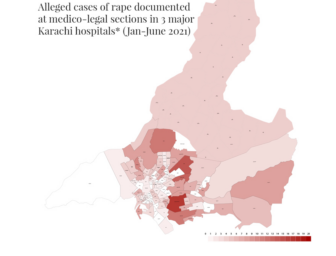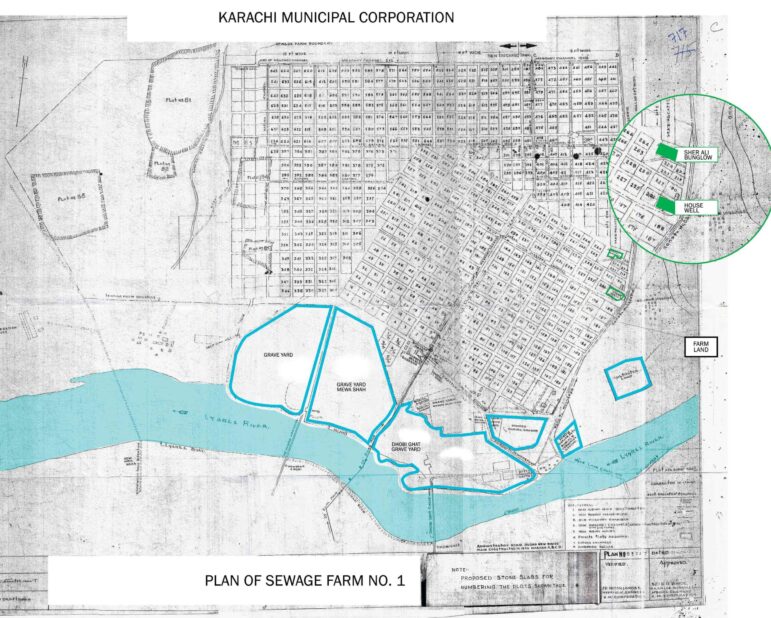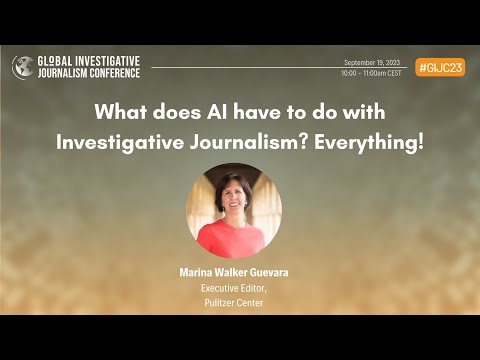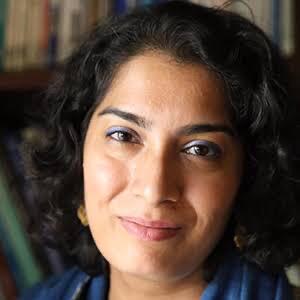

Uncovering Karachi: Using Maps and Data to Investigate Problems in a Modern Metropolis
Karachi is Pakistan’s largest city and financial capital, but it is also a place with the dubious reputation of being one of the most unlivable cities in the world.
The problems are not hard to spot: The residents of this sprawling coastal metropolis face urban flooding, a lack of clean water, and deficient public transport. These daily struggles are coupled with the city’s history of political violence.
But some of these challenges provide fertile ground for investigative reporting. Year after year, some of the country’s best stories come from exploring the land mafia, Karachi’s disappearing coastline, gangs who profit by selling government water on the private market, or simply analyzing the city’s crime data.
This happens despite the fact that public information in Pakistan is often hard to access, particularly in comparison to countries in the West. What’s more there is constant pressure on the media to censor information about certain individuals or factions within the state.
For some, like Mahim Maher, editor at Aaj English, an English-language site associated with the mainstream Aaj news channel, the drive to focus on Karachi’s longstanding systemic issues comes from a need to understand how her adopted hometown lives and breathes. “I’ve realized everything comes back to good governance,” says Maher, who grew up in London but now calls Karachi home.
Working on the city desk, Maher realized that many of her contemporaries on the old legacy newspapers were focusing on politics, which she found dull. Instead, she wanted to run stories that helped her make sense of the city, and explain its systemic problems and concerns in a way that allowed her audience to also get a handle on what was going on around them. And so she set out to make flyovers and sewage drains, as she puts it, “sexy.”
Digging into the stories of Karachi was also one of Oonib Azam’s first beats as a trainee reporter in 2015, and it’s one he has stuck with. Since starting out as a local city government reporter on the Metro pages of The Express Tribune, one of his areas of focus has been land grabbing — or acquiring property by fraud or force — for which Karachi is notorious. Where most reporters will quickly shun local city beats and move on to covering politics as they progress up the ranks, Azam says he has always been fascinated by the municipal administration. Now a reporter at The News International, one of the largest English-language newspapers in Pakistan, Karachi itself remains a source of many of his stories. “Also, no one is reporting on it so there is a lot of space to explore,” he says.
So, how do journalists find ways to dig into systemic municipal issues in the face of information gaps and antagonistic public officials? And what lessons can reporters in cities similar to Karachi learn from these experiences? We asked Azam and Maher for their best tips for getting information and digging into urban stories in a city as large and perplexing as Karachi.
Find Maps and Data

Mahim Maher and a colleague used police data to map alleged rape cases across Karachi. Image: Screenshot, Sama English
As a woman facing gender norms in a Muslim country, Maher knew she was going to have to find innovative ways of gathering information. While her male reporter colleagues could share traditional tea and coffee rituals with sources, or hang out at police stations to cultivate contacts and find out information, she needed another option.
Maps became essential to her, offering a way of “seeing a whole city that was otherwise denied to me,” she says. And data journalism meant she was able to provide readers with concrete information about the city’s problems, and by combining the two, she found a new way of reporting on Karachi’s nagging issues.
For one investigation, she dug into rape statistics across the city to try to identify trends in sexual assaults, mapping them so readers could visualize her findings. Once she had established how to collect the data, she then read into each case and input the figures into an Excel spreadsheet. By doing this, she was able to tell where cases took place, and identified higher numbers of incidents in working-class districts and industrial areas.
In another story, she used data given to her by a police source to plot confrontations and suspicious deaths involving the unit of a controversial high-ranking police officer.
Maps can also be useful for historical investigations. Azam’s story on Gutter Baghicha delved into how a public park, larger than New York’s Central Park, was slowly encroached and built upon, leading to the loss of “the largest urban green space of Asia.” The story carried two maps — dated 1946 and 2008 — which helped to show readers how the area had changed over time and showed who had benefited from the construction.
Tell Stories in New Ways

A map used to illustrate Oonib Azam’s investigation into private encroachment of Karachi’s largest public park. Image: Screenshot
Maher says many of the big, structural stories in Karachi remain the same on the surface, the challenge is to tell them in new and interesting ways, and to dig deeper. To do this, she brings together information for better comprehension. “Ensuring cognitive uptake of what I am putting down on paper,” she says.
In Azam’s story Heavy Toll of Development Frenzy on Karachi Coast for Third Pole, a news website dedicated to covering the Himalayan watershed areas, he used satellite imagery to show how the city’s waterfront had been reclaimed and built up with exclusive real estate over a decade. This has had myriad impacts on the city’s coastline: housing developments for the city’s rich now block access to the sea for fishing workers and for the Indigenous populations who used to live there. It has also had significant environmental consequences.
“I use Google Earth often in my work, because it’s such an easy tool and it really helps you see how and where land was encroached upon over time,” says Azam. He also reached out to the country’s National Institute of Oceanography for a few tools “that helped me look at land reclamation,” he says.
Find Alternative Sources
Maher and Azam’s experiences show that journalists reporting on systemic municipal issues can triangulate their sources where there are gaps in public records: approaching NGOs, academics, think tanks, and individual government officials for information.
“There are some really good academics working at the grassroots level in Karachi and they know what’s happening. And at times that differs from what the picture within the bureaucracy is,” explains Maher.
Often it is by comparing different responses that reporters are able to track down the truth. “I only stop interviewing when everyone starts saying the same thing,” she adds.
Establish Facts
When Maher first started working in a newsroom 20 years ago, data was not a big thing. “The absence of data, either it paralyzes you or you become more curious,” she says. She became curious.
The information gaps led her on a quest for what she calls stories backed up by a “stable fact… one that you can put in a story and it will stand the test of time.” That, however, is extremely difficult to find in a city like Karachi.
She gives an example of a figure she looked into when working on a story about Karachi’s water supply. She wanted to answer a very basic question: How much water did the city need to function? One or two figures were repeated in everything she read, but it took a long time to track down the original source: a report by a Karachi activist and a research project that were just cited again and again. “If, as a journalist, you write down these absolutes” without questioning them, she says, “then you will run into trouble.”
Don’t Overlook the Value of Every Document
Maher says she looks at all kinds of documents created during various bureaucratic processes, including tender notices, notifications, and announcements, but cautions reporters to be careful to fully understand them before using them. “Don’t make assumptions,” she says.
Azam also uses court records in his stories — since these are often easier to get hold of than official records. For his stolen land series, he says they have proven to be particularly fruitful. “It’s very important to look into court cases filed against land grabbing. Most of the case files carry detailed maps of the area. Moreover, data of sorts can be acquired from civil society and independent NGOs who have been putting up resistance to land grabbing through court litigations,” he explains.
Develop a Beat
Maher says developing a beat — even within the structure of investigating the city — is important. “Don’t try to do everything,” she warns.
Azam says his municipal “beat” has stuck with him, even as he switched news organizations. “I have been covering local governments from whichever news outlet I have joined during my career as an investigative journalist,” he says.
This has helped him not only understand issues at a deeper level, but also given him great leads. During a discussion on local governments, he got a tip that garbage dumping sites were being used as a way to illicitly take control over land within the city. So he meticulously observed how pieces of land are leveled first — to mark them as a site to be later encroached on — and then used as a garbage dumping ground, before ultimately being “grabbed” for development.
Investigating and writing about city administration is so important, says Azam. “It is eventually what causes so much human suffering but something no one talks about. Especially in a large metropolis like Karachi, how do you not talk about how this city is governed and run?”
Additional Resources
2022’s Best Investigative Reporting from Pakistan
Sujag: Investigative Journalism from the Margins of Power in Pakistan
9 Leadership Tips for Women in Investigative Journalism
 Amel Ghani is GIJN’s Urdu Editor. She has reported on everything from the rise of religious political parties in Pakistan to the environment and digital rights. She is a Fulbright Fellow and holds a Master’s degree in journalism from Columbia University, where she specialized in investigative journalism.
Amel Ghani is GIJN’s Urdu Editor. She has reported on everything from the rise of religious political parties in Pakistan to the environment and digital rights. She is a Fulbright Fellow and holds a Master’s degree in journalism from Columbia University, where she specialized in investigative journalism.
Ayaz Khan is a researcher and journalist based in Pakistan. He covers climate change and is a member of the Oxford Climate Journalism Network (OCJN), a program of the Reuters Institute for the Study of Journalism at the University of Oxford. He has worked for Dawn and other outlets.












